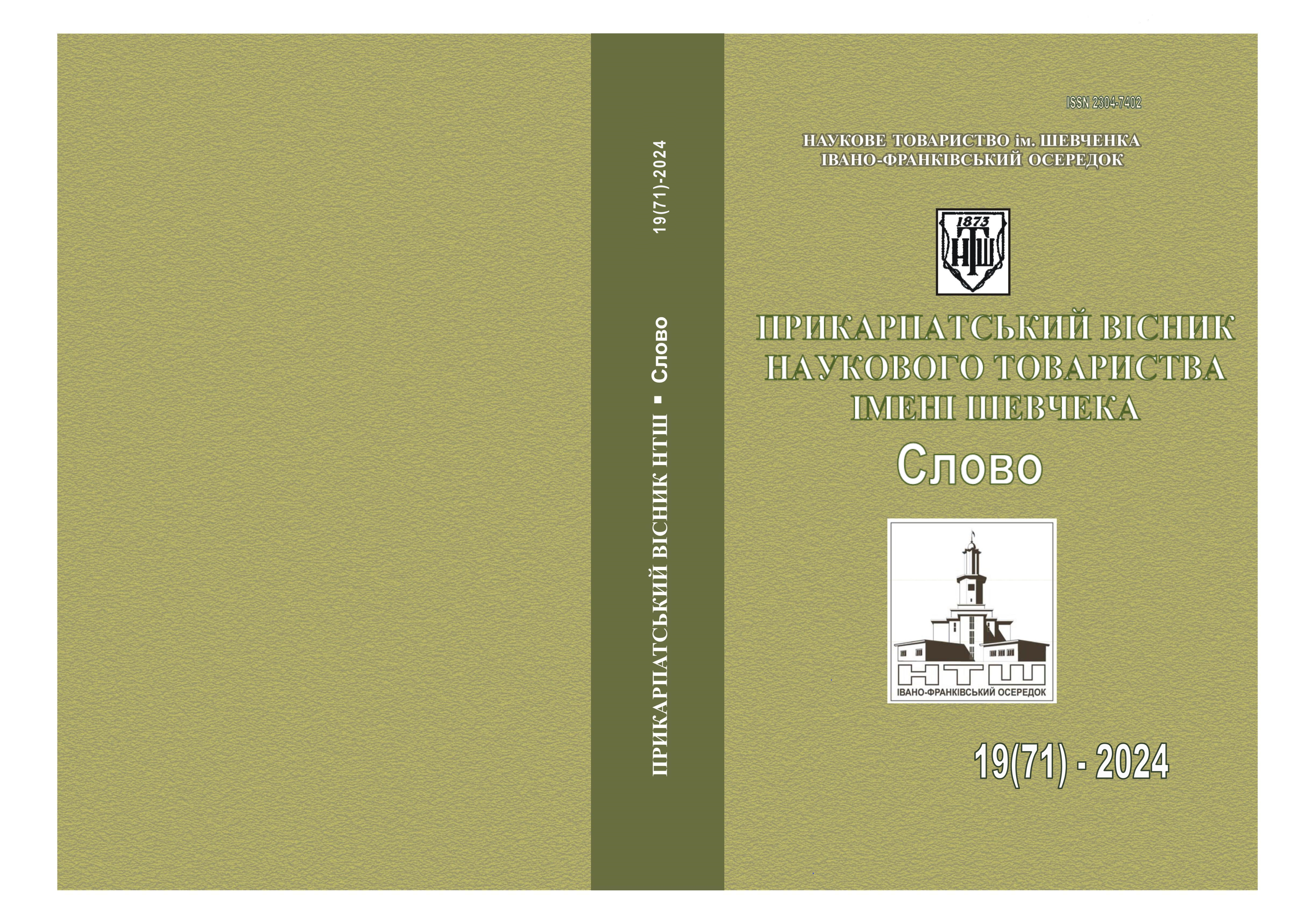THE PSYCHO-PHONO-SEMANTIC POTENTIAL OF SONORANTS IN UKRAINIAN AND POLISH LANGUAGES
(an experimental study)
DOI:
https://doi.org/10.31471/2304-7402-2024-19(71)-129-141Keywords:
psyhofonosemantics, Ukrainian resonant sounds, Polish sonorous sounds, phonetic content, coloured scale of sounds, articulatory-acoustic features of sounds.Abstract
The article is dedicated to the current direction in linguistic science, which is the study of phonetic content and colourful associations of the Ukrainian and Polish resonant sounds.
The study aims to establish the psycho-phono-semantics of Ukrainian and Polish sounds and to find out their specificity in a comparative aspect.
The methods used in our study are analysis and synthesis, induction and deduction, comparative, sociolinguistic and quantitative analysis, questionnaire, and free-associative and purposeful associative experiments. The research is based on the psychometric method of studying the symbolic meaning of speech sounds, the method of semantic differential by Charles Egerton Osgood.
Based on experiments the coloured scale of the resonant sounds of the indicated languages is completely investigated. Their phonetic content and the noticeable connections between them are proven. Also, we confirmed the influence of the articulatory-acoustic features on the sounds. For example, rough, sad, wicked, dark [p] coloured in black, but beautiful, merry, tender, loud, light, [л'] in yellow colour; good, kind, cheerful, gentle, fast, loud, weak, hot, small, light [n'] coloured in white; bad, big, gentle, strong, cold, fast, sad, loud, angry, light [r] - in black. The respondents identified Ukrainian sound [м] as beautiful, rude, strong, cold, slow, sad, quiet, evil, large, dark, red; [н'] as beautiful, small, tender, weak, hot, fast, cheerful, quiet, kind, light, violet; [р] as bad, rude, strong, hot, fast, sad, loud, angry, big, dark, black; [p '] as beautiful, kind, tender, strong, hot, fast, merry, loud, small, bright, blue; [л] as beautiful, great, kind, tender, fast, strong, merry, loud, cold, light, blue; [л '] as beautiful, tender, weak, hot, slow, cheerful, loud, angry, small, light, yellow; [в] as beautiful, kind, rude, strong, hot, fast, cheerful, quiet, light, white; [й] as bad, rough, weak, cold, fast, sad, loud, good, small, dark, green. Respondents defined the Polish sound [m] as good, rough, strong, cold, fast, sad, loud, angry, big, dark, red; sound [n] as bad, kind, tender, light, weak, hot, slow, cheerful, quiet, small, brown; sound [r] as good, tender, hot, slow, cheerful, small, brown; sound [n'] as good, gentle, weak, hot, fast, loud, kind, cheerful, small, light, white; sound [r] as bad, gentle, strong, cold, fast, sad, loud, angry, big, light, black; sound [l] as good, kind, gentle, strong, hot, fast, sad, quiet, big, light, blue; sound [l'] as good, kind, gentle, weak, hot, fast, cheerful, quiet, small, light, yellow; sound [m'] as good, gentle, weak, hot, slow, cheerful, quiet, kind, small, light, blue; sound [j] as bad, gentle, weak, hot, slow, sad, quiet, kind, big, light, green.
The greatest number of characteristics coincides with sounds [н'], [n'] and the smallest for sounds [й], [j] while comparing Ukrainian and Polish sonorants. Аmong the Ukrainian sonorants, most of the values coincide with the sounds [н] and [н'], [л] and [л'], [в] and [j]. Among Polish sonorants, most of the values coincide with the sounds [l] and [l']. The colours of Ukrainian and Polish sonorants are identical, except that Polish [n'] is white and Ukrainian [н'] is purple.
Ukrainian and Polish sonorants are characterized by rich phonetic values and a bright colour spectrum. Thus, based on psycho-phono-semantic interpretations of sounds, we can indicate a linguistic picture in which the phonetic (phonographic, or more broadly, phonosemantic) level is involved, i.e. elements of the linguistic phono-sphere can actualise elements of the linguistic picture. The psycho-phono-semantics of Ukrainian and Polish sonorants represent a universal (national) linguistic picture which is specific to each language, as it contains its own set of semantic characteristics of sound.
References
Войцева О. Польська мова: Навчальний посібник. Чернівці : ВД «Букрек», 2007. 384 с.
Дружинець М. Л. Психофоносемантика та кольорові асоціації українських та польських сонорних звуків. Мiжкультурна комунiкацiя: проблеми та перспективи: зб. наук. праць / Відп. ред. М. Л. Дружинець. Одеса–Тирасполь, 2012. С.167-174.
Левицький В. В. Символічні значення українських голосних і приголосних. Мовознавство. 1973. № 2. С. 36–49.
Левицький В. В. Чи існує універсальний звукосимволізм? Мовознавство. 1972. №1. С. 25–37.
Найдеш О. В. Явище фоносемантизму в сучасній німецькій мові (на матеріалі консонантних сполучень): дис. канд. філол.наук: 10.02.04. Чернівці, 2000. 215 с.
Українська мова. Енциклопедія / Русанівський В. М., Тараненко О. О., Зяблюк М. П. та ін. Київ : Вид-во «Українська енциклопедія» імені М. П. Бажана, 2000. 752 с.
Фаріон Ірина. Краса і сила: суспільно-креативна роль української мови в XI – середині XIX ст. Львів: Вид-во Національного університету «Львівська політехніка», 2007. 168 с.

